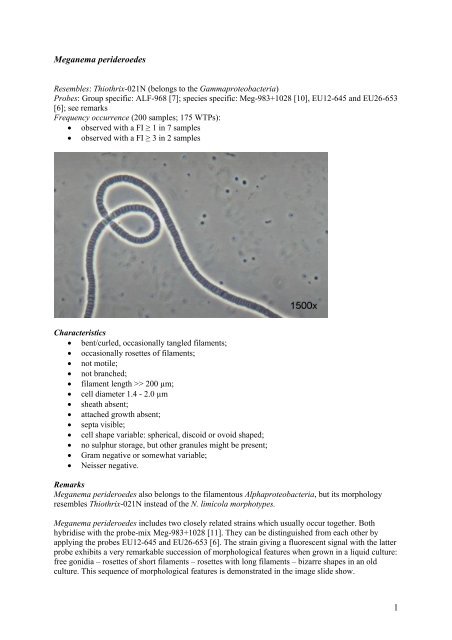1 Meganema perideroedes
1 Meganema perideroedes
1 Meganema perideroedes
You also want an ePaper? Increase the reach of your titles
YUMPU automatically turns print PDFs into web optimized ePapers that Google loves.
<strong>Meganema</strong> <strong>perideroedes</strong><br />
Resembles: Thiothrix-021N (belongs to the Gammaproteobacteria)<br />
Probes: Group specific: ALF-968 [7]; species specific: Meg-983+1028 [10], EU12-645 and EU26-653<br />
[6]; see remarks<br />
Frequency occurrence (200 samples; 175 WTPs):<br />
• observed with a FI ≥ 1 in 7 samples<br />
• observed with a FI ≥ 3 in 2 samples<br />
Characteristics<br />
• bent/curled, occasionally tangled filaments;<br />
• occasionally rosettes of filaments;<br />
• not motile;<br />
• not branched;<br />
• filament length >> 200 µm;<br />
• cell diameter 1.4 - 2.0 µm<br />
• sheath absent;<br />
• attached growth absent;<br />
• septa visible;<br />
• cell shape variable: spherical, discoid or ovoid shaped;<br />
• no sulphur storage, but other granules might be present;<br />
• Gram negative or somewhat variable;<br />
• Neisser negative.<br />
Remarks<br />
<strong>Meganema</strong> <strong>perideroedes</strong> also belongs to the filamentous Alphaproteobacteria, but its morphology<br />
resembles Thiothrix-021N instead of the N. limicola morphotypes.<br />
<strong>Meganema</strong> <strong>perideroedes</strong> includes two closely related strains which usually occur together. Both<br />
hybridise with the probe-mix Meg-983+1028 [11]. They can be distinguished from each other by<br />
applying the probes EU12-645 and EU26-653 [6]. The strain giving a fluorescent signal with the latter<br />
probe exhibits a very remarkable succession of morphological features when grown in a liquid culture:<br />
free gonidia – rosettes of short filaments – rosettes with long filaments – bizarre shapes in an old<br />
culture. This sequence of morphological features is demonstrated in the image slide show.<br />
1
The probe EU12-645 positive strain does not form gonidia or rosettes, but grows in axenic cultures as<br />
long filaments composed of spherical or more ovoid shaped cells.<br />
The morphotypes hybridising with the probes EU12-645 and EU26-653 were tentatively named<br />
Megathrix tenacis and Megathrix sidereus respectively, in a paper dealing with the Macobs results<br />
[11]. These names are not used any longer.<br />
See "Candidatus Alysiomicrobium bavaricum" for additional remarks, physiology, occurrence in<br />
activated sludge, control options and references.<br />
Slide show images<br />
• Filaments in activated sludge<br />
o 1: morphology at a low magnification<br />
o 2-13: morphology at a high magnification<br />
� 2-5: discoid cells<br />
� 6-10: spherical or ovoid cells<br />
� 11-13: in situ formation of gonidia, rosettes and knots<br />
o 14: occasionally Gram variable<br />
o 15: FISH image with probe EU26-653<br />
• Photos of filaments in pure cultures. These images were made in 1975 and the pure cultures<br />
have not been stored. It is therefore not absolutely certain that the strains available at that time<br />
were identical to the <strong>Meganema</strong> pure cultures giving hybridisation signals to the probes EU12-<br />
645 and EU26-653. The morphological features of the strains isolated in 1975 are, however,<br />
identical to those of the recently isolated strains in Italy and Denmark.<br />
o Culture strongly resembling the probe EU26-653 positive strain. The images show the<br />
development of the biomass after transferring some biomass into a fresh liquid<br />
medium.<br />
� 16: So-called gonidia are formed from the end of an ‘old’ filament<br />
� 17: free gonidia develop knobs by which they attach to each other at their<br />
basis � rosette<br />
� 18-24: formation and maturing of rosettes<br />
� 25-28: matured filaments; often filled with stored compounds<br />
� 29-31: bizarre shapes in old cultures<br />
o Culture strongly resembling the probe EU12-645 positive strain<br />
� 32-37: Neither gonidia, nor formation of rosettes. Filaments might be filled<br />
with stored compounds and large bundles of filaments were sometimes<br />
observed<br />
2


